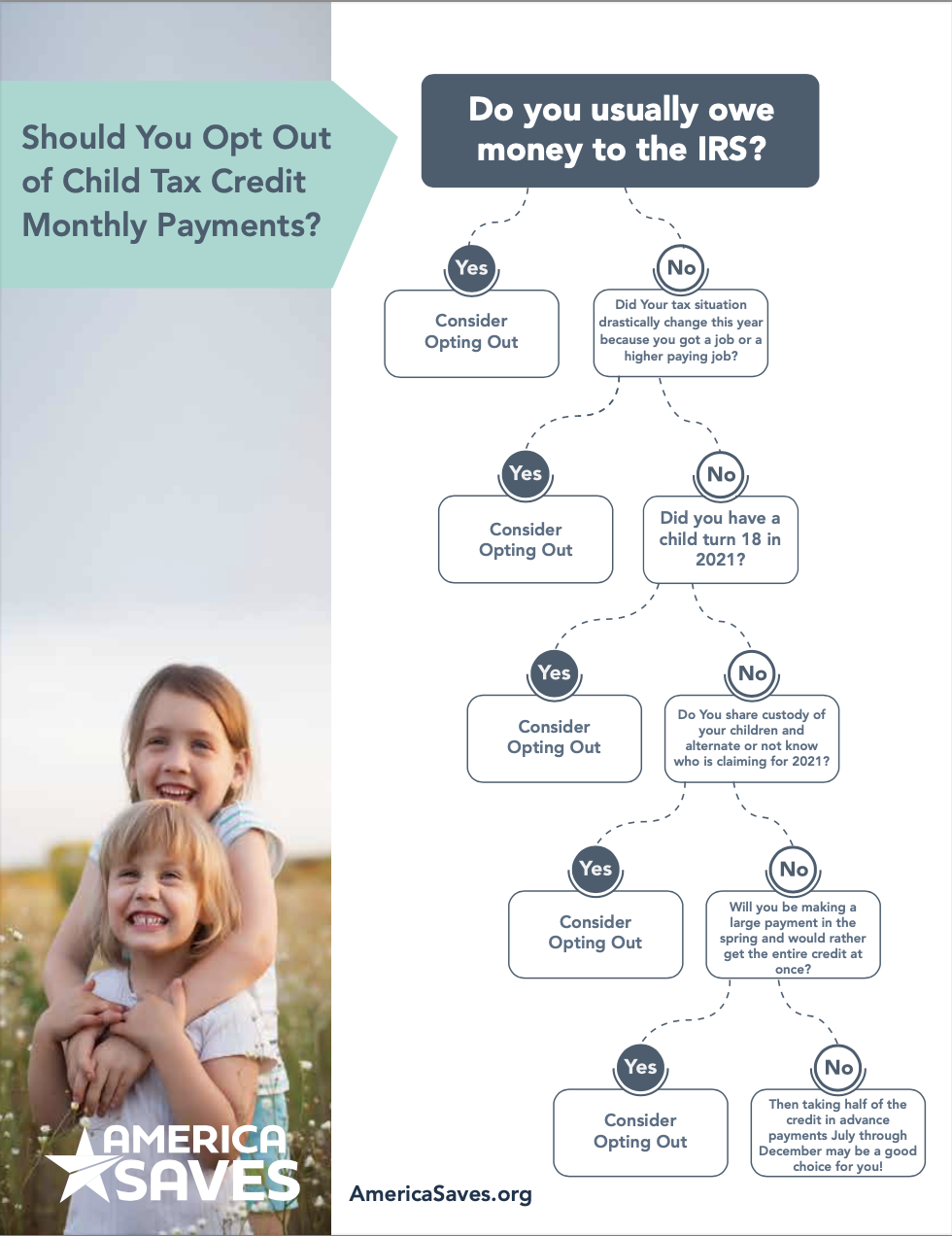What you need to know about the 2021 Child Tax Credit Changes
Under the American Rescue Plan Act of 2021, the new Child Tax Credit is a refundable credit worth up to $3,600 per qualifying child under 18. These changes are an increase from last year’s Child Tax Credit benefit of $2,000.
Related Topics
Qualifying families will receive half of their credit divided into 6 monthly payments deposited from July to December 2021. Families will receive the rest of the tax credit when they file their 2021 income taxes next year.
To be eligible for the credit, you must claim dependent children 17 and under who are a U.S. citizen, national, or resident alien and have a Social Security number. The child must be related to you and live with you at least six months of the year.
The benefit amount is determined by three factors per child: 1) the age of the child (under 6 or 6-17), 2) your filing status (single or married filing jointly), and 3) your modified adjusted gross income. The maximum benefit is $3,600 per child under age 6 and $3,000 for those older than 6 and under 18 years old; adults who file single are eligible for the maximum credit if their modified adjust gross income in 2021 is $75,000 or less, or $150,000 or less for married filing jointly adults. Once taxpayers reach these income thresholds, the benefit is gradually reduced to $2,000 per child.
The early distributions are automatically set to roll out starting in July 2021. The IRS will take the estimated credit you are due based on your 2020 taxes – for example, $3000 for a 16-year-old – and divide it in half, which is $1500. Then they will further divide it into 6 payments, which would be $250 ($1500/6). In this example, a family could expect to receive $250 per month from July to December and then the rest of the credit, $1500, in 2022, when they file their tax return next year.
If you didn’t file a return in 2020, then the IRS will look at 2019. For those who are not required to file taxes, the IRS has provided a portal for non-filers to submit information.
There are, however, some taxpayers who may choose to opt-out of the advance payments on the IRS website and file for the full payment on their next tax return. If you receive higher payments than you are eligible for on your 2021 taxes, you will have to pay back the IRS any amounts that you are overpaid.
Reasons to opt out of the payments – do any of these situations apply to you?
- You usually owe money to the IRS
- Your tax situation has drastically changed this year because you got a job or a higher paying job
- You have children who are aging out of qualifying
- You share custody of your children and have not worked out who is claiming the credit
- You know you will be making a large payment in the spring and would rather get the entire credit at once
Reasons to take the advance payments: anything other than the above!

2021 Child Tax Credit Decision Tree
If you can check yes to all of these, then you might be eligible for the increased 2021 Child Tax Credit:
- Child is under 2) a U.S. citizen, national or resident alien 3) has a Social Security number 4) you claim them as a dependent on your tax return 5) child is related to you and 6) lives with you at least six months of the year.
And you can receive up to $3,600 per child. Single filers making $75,000 or less (or married filing jointly of $150,000 or less) who have a child under 6 will receive the maximum benefit of $3,600, whereas these groups will receive a $3,000 benefit for a child 6 – 17. Single filers making $75,000 to $200,000 will get a credit of at least $2,000; married filing jointly will get at least $2,000 if they make $150,000 to $400,000. The exact benefit amount decreases in $50 increments for every $1,000 over the income thresholds.
If you don’t opt out, you will get half of your credit in 6 monthly payments July through December, and the other half when you file your 2021 taxes.

The 2021 Child Tax Credit Benefit Amount Chart
The 2021 Child Tax Credit increases the potential credit up to $3600 per child and is being distributed in two parts: half July through December and the other half when you file your 2021 taxes.
If you can check yes to all of these, then you might be eligible for the benefit:
- Child is under 2) a U.S. citizen, national or resident alien 3) has a Social Security number 4) you claim them as a dependent on your tax return 5) child is related to you and 6) lives with you at least six months of the year.
If you are Single Making:
Less than $75,000
- Each child up to 5 years old on 12/31/2021 = Benefit of $3,600
- Each child 6 - 17 years old on 12/31/2021 = Benefit of $3,000
$75,000 - $200,000
- Each child up to 5 years old on 12/31/2021 = Benefit of $3,575 - $2,000
- Gradually reduced in $50 increments by AGI over $75,000
- Each child 6 - 17 years old on 12/31/2021 = Benefit of at least $2,000
- Gradually reduced in $50 increments by AGI over $75,000
Over $200,000
- Each child up to 5 years old on 12/31/2021 = For each $1,000 over $200,000, reduce $2,000 credit by $50
- Each child 6 - 17 years old on 12/31/2021 = For each $1,000 over $200,000, reduce $2,000 credit by $50
If you are Married Filing Jointly, Making:
Less than $150,000
- Each child up to 5 years old on 12/31/2021 = Benefit of $3,600
- Each child 6 - 17 years old on 12/31/2021 = Benefit of $3,000
$150,000 - $400,000
- Each child up to 5 years old on 12/31/2021 = Benefit of $3,575 - $2,000
- Gradually reduced in $50 increments by AGI over $75,000
- Each child 6 - 17 years old on 12/31/2021 = Benefit of at least $2,000
- Gradually reduced in $50 increments by AGI over $75,000
Over $400,000
- Each child up to 5 years old on 12/31/2021 = For each $1,000 over $200,000, reduce $2,000 credit by $50
- Each child 6 - 17 years old on 12/31/2021 = For each $1,000 over $200,000, reduce $2,000 credit by $50
Related Tags
CHECK OUT OTHER SAVINGS JOURNEYS FROM SAVERS JUST LIKE YOU
Budget like Nohemi
By Nohemi
Nohemi found out about America Saves a few years ago as an undergraduate at the University of Illinois at Chicago. She remembers attending a University of Illinois Saves event where she decorated a piggy bank and took the Pledge, but college life made her put the thought of saving at the back of her mind.
The Gift of Homeownership
By Quaneka Willis
Quaneka Willis, a single mother of three children, was receiving rental assistance through the Housing Au...
Another Dream Realized
By Mary Brown
Mary Brown was already a disciplined individual when she came to Wisconsin Saves coordinator Wisconsin Wo...
Saving With My Boys
By Kelly
Kelly has made saving a family effort. She started her boys saving early. “Probably 3,” Kelly told us, “w...
Saver Story: Set a goal, make a plan!
By Shannon
We've chosen Shannon as our Saver of the Month! Her approach to saving for her family’s dream home is a g...
Savings #ImSavingForSweepstakes
#ImSavingFor Winner Story
By Pedram R.
America Saves awarded one lucky saver, Pedram R. from California, $750 for sharing his #ImSavingFor story. Pedram said, “Saving is important to me because it proves I am not willing to buy unnecessary things to please others or to be perceived as successful.”
Taking Steps Toward Financial Fitness
By Nicky Vasquez
Nicky Vasquez learned about Virginia Saves when she attended her first class with Bank On Virginia Beach....
Budget like Nohemi
By Nohemi
Nohemi found out about America Saves a few years ago as an undergraduate at the University of Illinois at...
A Think Like A Saver Attitude
By Melissa
Melissa has always been thrifty with a #ThinkLikeASaver attitude. This served her family well when her hu...
Saving for a Bright Future
By Kristin Hendricks
Kristin Hendricks, a single mother from Texas, understands the importance of saving money and following a...
A Think Like A Saver Attitude
By Melissa
Melissa has always been thrifty with a #ThinkLikeASaver attitude. This served her family well when her husband lost his job in 2014. Using their savings, Melissa’s family stayed afloat while her husband found a new job.
A Think Like A Saver Attitude
By Melissa
Melissa has always been thrifty with a #ThinkLikeASaver attitude. This served her family well when her husband lost his job in 2014. Using their savings, Melissa’s family stayed afloat while her husband found a new job.
Saving With My Boys
By Kelly
Kelly has made saving a family effort. She started her boys saving early. “Probably 3,” Kelly told us, “w...
Jump-Starting a Financial Makeover
By Nichelle Johnson
Nichelle Johnson, a single mom with two teenage children, knows what it’s like to stretch a dollar. When ...
Saving is a Family Affair
By Jeff
Saving is truly a family affair for Jeff’s household. During America Saves Week 2019, he pledged to save ...
Don’t Laugh at Saving Spare Change
By Brittany
Virginia Saves saver, Brittany, decided to start saving again when she became a single mother. She thinks...
Starting and Continuing a Personal Finance Journey
By Kiara Hardin
When Kiara Hardin, now a junior at Western Illinois University, became an intern with the Chicago Summer Business Institute during her sophomore year of high school, she began her personal finance journey.
Saving is a Family Affair
By Jeff
Saving is truly a family affair for Jeff’s household. During America Saves Week 2019, he pledged to save ...
Saving With My Boys
By Kelly
Kelly has made saving a family effort. She started her boys saving early. “Probably 3,” Kelly told us, “w...
Put 20 Percent Away
By Melissa
“I am a single mother, and I make ends meet for me and my daughter, but I wanted to put money away for my...
Budget like Nohemi
By Nohemi
Nohemi found out about America Saves a few years ago as an undergraduate at the University of Illinois at...
Getting Out of Debt
By Tonya Shelton
In 2004, Tonya Shelton was facing financial ruin. Barely making more than minimum wage and having lost her home to an unexpected family crisis, Shelton and her family were forced to live in a rundown hotel.
Inspired to Build Savings By Starting Small
By Sharon
With little-to-no money in the bank and living on a limited income with her adult daughter, Sharon wasn’t...
Taking Back Control Over Finances
By Nadine Bialo
After becoming a Virginia Saver and getting help from BankOn classes and coaching, Nadine Bialo took back...
From Overwhelmed to In Control
By Debi
In 2017 Debi felt overwhelmed. Her credit cards were maxed, and she wasn't exactly sure how to handle it....
Developing a Savings "Game Plan"
By Eunice Diaz
Eunice Diaz, a teacher in Colorado Springs, had been noticing a pattern. Despite the fact that she and he...
Savings #ImSavingForSweepstakes
#ImSavingFor Winner Story
By Pedram R.
America Saves awarded one lucky saver, Pedram R. from California, $750 for sharing his #ImSavingFor story. Pedram said, “Saving is important to me because it proves I am not willing to buy unnecessary things to please others or to be perceived as successful.”
Saving is a Family Affair
By Jeff
Saving is truly a family affair for Jeff’s household. During America Saves Week 2019, he pledged to save for retirement. But making a commitment and creating a plan to save isn’t a new concept for him.
Getting Out of Debt
By Tonya Shelton
In 2004, Tonya Shelton was facing financial ruin. Barely making more than minimum wage and having lost her home to an unexpected family crisis, Shelton and her family were forced to live in a rundown hotel.
If we feature you in our newsletter, you get $50.
You May Also Be Interested In...
Take the America saves pledge
Make a pledge to yourself and create a simple savings plan that works. Complete the Pledge and America Saves will send you short email and text reminders, resources and tips to keep you on track towards your savings goal. Become part of an entire community of savers. Get started now!
creative ways to fund your savings
Those with a savings plan are twice as likely to save successfully. Taking the America Saves Pledge is a pledge to yourself to start a savings journey and America Saves is here to encourage you along the way. Take the first step toward creating a better financial future. Make a plan, set a goal, and pledge to yourself to start saving, today.

Congrats on completing the pledge!

Congrats on completing the pledge!
We are so glad you have started your savings journey and Military Saves will be right beside you the whole way! You will soon receive an email from the Military Saves team to help encourage you. Find helpful links below to continue researching topics on saving.

Take the America Saves Pledge
Make a pledge to yourself and create a simple savings plan that works.




